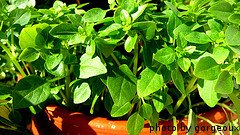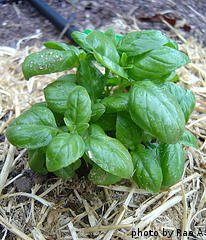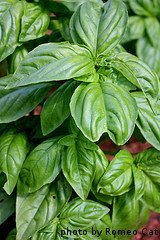How To Water Basil
And Fertilize It
Ready to learn how to water basil? You should be watering basil plants every week or so, depending on the amount of rainfall in your area. This will help your basil plants reach their maximum size and produce the most leaves. It's a good idea to fertilize basil plants every 4-6 weeks, depending on your soil conditions and length of your growing season.
How To Water Basil - Step by Step

Basil plants do best when the soil is moist. When irrigating basil plants, focus your efforts at the base of the plants. Mildew and fungus tend to grow on wet leaves and foliage. If you don't water the tops of the plants, the less likely that your basil will be affected by diseases. It's a good idea to water in the early morning hours. This way, the afternoon sun will evaporate any unused water. If it rains in your area, you may not need to water your basil plants at all. Using your fingers, dig down into the soil a few inches next to the plants, being careful not to disturb the roots. Grab a handful of soil and squeeze it in your palm. If the soil is moist and hold together briefly when pressed before slowly crumbling, you're in good shape. If the soil at this depth is dry and crumbly, it's probably time to water. If the soil is soggy and you are able to squeeze water out of it, wait a few days and check again. Basil plants are fairly resilient, but they will fail if they sit in soggy soil or very dry soil for extended periods of time.
When it comes to watering basil plants, a slow, deep soaking method of watering is best. Avoid using high pressure sprayers or hoses as this may cause erosion of the soil around the plant. A watering can or very slow running garden hose or soaker hose all work well. The idea is to keep the soil moist but not waterlogged. Basil plants will wilt and die if they sit in soggy soil for too long.

A layer of mulch can be applied around your basil plants. This helps keep the moisture in the soil and also prevents weeds. Grass clippings, straw or chopped up leaves work well as mulch. Another benefit of using mulch is that it can be later tilled back into the soil to add nutrients.
Fertilizing Basil
Basil plants will do well with a small dose of fertilizer every 4-6 weeks. You can use a water-soluble type fertilizer or a granular product. If you choose a water-soluble type, mix it with water according to the manufacturer's directions. Apply it when you would normally water the plant.
If you choose a granular type fertilizer, choose a balanced one with equal amounts of nitrogen, potassium and phosphate. 10-10-10 or 12-12-12 formulas work well for fertilizing basil. Scatter the granules around the plant and water them in well. Try not to let the granules come in contact with the plant as this may cause it to burn. Most granular fertilizers are applied at a rate of 1 1/2 pounds per 100 square feet. If growing basil in containers, scatter a small handful of granules on top of the soil around the plant.
In our own garden, we start by mixing composted manure into the area where we're going to plant our basil seeds. We then scatter a balanced granular fertilizer product over the area where we will plant. We usually apply it at a rate of 1 pound per 100 square feet. Since we plant our basil in a single row, we end up using about half a pound for our 10 basil plants that we typically grow every year. Once the fertilizer is applied, we till it into the soil one last time before planting. After that, we switch to a water-soluble fertilizer product and apply it to our basil plants a couple of more times throughout the growing season, depending on how much we have to water our basil plants.
If you continue fertilizing and watering basil on a regular basis throughout the growing season, your plants will have an excellent chance of producing more than enough of fresh basil for you and your family. The idea is to keep the plants as healthy and happy as possible for as long as possible. If you are successful in doing this, you'll probably be rewarded with more basil leaves than you'll know what to do with.
Once the basil plants get big enough, it's time to harvest those succulent leaves.

Click here to learn about harvesting basil
Click here for some of our favorite basil recipes
Click here for information about different basil varieties
Click here to move from our How To Water Basil page to our Growing Basil main page
Click here to return to our Home page